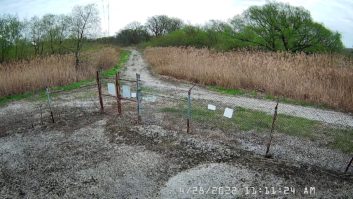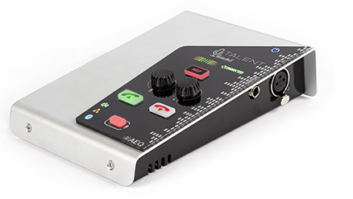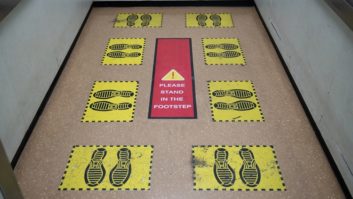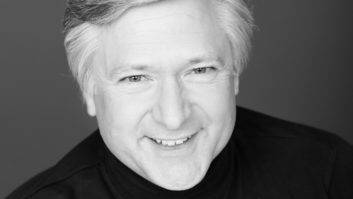
CREDIT: iStockphoto/hh5800 A recent series of threads on the public radio technical Listserv brought to light a number of cases where FM stations were accused of creating interference to 4G installations.
The more that I dug into this question, the more cases I found. The problems had emerged at what is now known to the tower industry as “co-location sites.” The origin of this term likely originates in zoning language that has become nearly universal in densely populated areas, such as the Northeast Corridor. During the great RFR scare of the 1980s, in which many people first learned of the possible dangerous effects of high levels of radio frequency energy, there was a rapid movement to prevent tower construction as a way of keeping any “hazards” at a minimum; in effect, all towns wanted to make sure that any new towers were built in any other town but their own.
Zoning rules quickly were enacted to prevent tower construction and just as quickly overturned by federal courts. A compromise was developed, creating the situation we have today: Towns can’t categorically prevent the construction of towers, but they can create designated locations that limit towers to certain defined areas. Furthermore, towns are allowed to require that new tower proponents make all efforts to “co-locate” their new facilities on existing towers or nearby.
As the cellphone industry went through rapid growth in the 1990s and early 2000s, engineers developed tower sites at workable distances that combined the antennas for multiple carriers, such as Verizon, ATT, Sprint, etc. Instead of covering our landscape with competing towers as carriers came and went, the sites were developed with enough capacity that pretty much everyone that wanted to put coverage in an area was able to lease it without having to construct a new tower. Co-location sites are now very common because of this compromise. It’s not a bad solution at all, really.
IN IT TOGETHER
How does this affect the radio broadcast industry? The FM band had reached relative “maturity” in the 1970s, but as the popularity of FM grew, so did demand that new channels be allocated. Thousands were famously created by the “Docket 80-90” ruling in the 1980s. In effect, if one could show a location for a new transmitter with a specified power that would not cause interference to any existing stations, it could be added to the Table of Allocations for someone to build.
These modifications to the Table of Allocations continued to occur right up into where the cell industry began its massive expansion. Rather than build standalone towers, many new FMs would find that locating on an existing tower saved both money and construction delays due to increasingly difficult zoning laws. At the same time, required to co-locate wherever possible, cell companies began to discuss putting new antennas on with existing tower owners, such as broadcasters. Vertical space on existing FM towers often was unused at the heights preferred by cell carriers (just enough to cover a cell area, as opposed to our typical efforts to maximize service area to the bounds of interference). Additionally, there were several significant application “windows” opened up for translators and LPFMs, effectively low-power stations that don’t fit the minimum power requirements for standard class protections, creating several thousand more new licenses. Finally, there was the large wave of NCE stations created by the application window of 2007.
The result is that cell phone companies and FM radio stations of all kinds have ended up sharing the same site. And for the past couple of decades, we have coexisted with reasonable success.
That’s why it’s a bit disconcerting to hear about cell companies suddenly telling FM stations they were causing destructive interference to the latest 4G technology, and even requesting these stations be issued a Notice of Violation and fines. Often the cell company directly informs the pre-existing FM station of the interference using official language, while implying the entire fault lies with improper operation by the FM owner. But it’s not entirely clear that it’s a case that could stand up legally under the current rules.
HARMONIC DISHARMONY
As a longtime radio engineer, I find this whole situation surprising because it’s unusual to see interference popping up between services that are allocated properly and so widely separated.
FM stations operate from 88 to 108 MHz while the new 4G LTE service is being created in the 700–799 MHz region vacated by UHF television during the conversion from analog to digital TV. This isn’t a case of adjacent channels creeping over the guard band and into one another, but rather a more subtle form of interference that comes from the tendency of amplifiers to generate a quantity of harmonic spurs above their center frequency.
For example, if we consider the 8th harmonic of 95.1 MHz, we are smack dab in the middle of the 700 MHz band (760.8 MHz). If sufficient energy is present, this could impact the error rates achieved by a cell carrier operating 4G equipment at a co-located site.
Why are FM transmitters susceptible to creation of harmonics? This is a fundamental property of the Class C amplifier that is nearly universally used for generation of FM. Class C amplifiers are energized for only a small portion of one cycle of an FM carrier sine wave. Effectively, the amplifier is turned on and off by what is a square wave with a duty cycle less than 180 degrees. When we talk about the bias level of an FM amplifier (whether tube or solid-state), we are discussing the amount of time the FM waveform gets above the bias voltage to energize the final amplifiers. The duty cycle is designed to be just long enough that the carrier sine wave is reproduced in the resonant portions of the amplifier and/or antenna. Class C amplifiers are extremely efficient and save enormous energy because of this short duty cycle. But this process brings with it harmonic distortion that extends high up in frequency unless it is filtered out by the transmitter. Any time an amplifier is turned on and off, harmonics are generated. As a side note, it is the nature of FM that such distortion has a minimal impact on the demodulated audio, even though only about 120 degrees of the modulated FM waveform is actually fed to the final amplifier.
MOVING STANDARD
The FCC has long regulated the performance of FM transmitters in section 73.317(d) of the commission’s rules to account for the tendency of all amplifiers to emit unwanted signals. The well-known standard for transmitters of greater than 5 kW states there should be no harmonic emissions greater than –80 dBc, where the “c” refers to the carrier power. Lower-power transmitters are given a less restrictive standard, perhaps with the understanding that as the power decreases, any such harmonics will only go a limited distance and thus are less likely to generate interference to other stations. These rules have been in place and have successfully governed operations in the FM band for at least 40 years, as well as preventing interference to other spectrum bands.
But in the above description, I think it’s possible to see the beginnings of a problem in the definition itself.
First, the measurement that defines acceptable harmonic emissions is variable. By relying on a ratio of harmonics to carrier power, one hasn’t created a universal standard of measurement, such as the amount of water in a liter or the standard length of a foot. The amount of acceptable interference itself changes to allow more for the higher-power stations, less for lower-power stations, and then more again as the station power goes below 5 kW. Second, from the perspective of a receiver located near an FM transmitter (essentially in the blanketing region), the amount of allowable interference can be greater or smaller depending on the size of the FM station and its proximity.
The rules date back to the early era of FM broadcasting when most stations were standalone and the receivers were in the hands of consumers often many miles away. Today, some FM antennas are located right above or below cell panels, which in 4G installations contain receivers that communicate with adjacent cell sites. At some co-located sites with several towers, multiple FM stations might be 200 feet from a cell tower, virtually guaranteeing a substantial energy lobe will intersect with a cell panel. This variation makes it hard for an FM station to even speak in the same terms as a cell carrier when it comes to interference. Depending on a number of factors, the level of potential interference received by the cell antenna could be relatively high, even though the FM station was operating within the FCC standard. The FCC rules were never really designed to handle this situation. That requires a superior level of site planning from the cell companies, and even active site surveys of RF levels, before placing new equipment that might experience interference.
It is even difficult to come up with a measurement regime for FM stations that would account for this new situation. Equipment performance measurements are typically taken at the sample port of a transmitter. In my experience, harmonics on recent model solid-state transmitters are virtually impossible to measure (they are below the analyzer noise floor) once you go beyond about the third harmonic as measured at the amplifier. But if we try to measure what a co-located receiver might experience, it gets difficult since that antenna is up in the air perhaps 200 feet, not at the sample port. If an antenna is used to make measurements, it must be calibrated for a wide range of frequencies and its directionality considered. Likewise, the receive antenna directionality must be considered (is it pointing right at your FM antenna and at the exact same height on an adjacent tower?). All other transmitters at the co-located property must be filtered out as best as possible to avoid contaminating the required measurements. These filters must themselves be calibrated for their effect on the harmonic measurements. The repeatability and accuracy of such measurements might not be terribly good at a complex site with lots of signals and multiple shared towers. Finally, in some situations, it turns out there is radiation of harmonics out of the transmitter cabinet itself. This is where things start to get especially tricky.
While the current emissions standard is perhaps not well suited for this particular task, I’m not suggesting that a rule change on FM emissions would be an easy or even desirable solution, as I’m not sure it would be possible to do so in a way that would work for all situations. Any such changes would require a lot of input from both the FM and the cell industry. It’s not clear there is an actual solution that would satisfy anyone and meet all combinations of sites, antennas and transmitters. Usually when it gets down to this level of detail, it is best for the two parties to try to work out a solution via improved engineering, rather than make a wholesale regulatory change that in the end, may not even solve the problem.
THE FIRST THING TO DO…
Back in 2013, the law firm of Fletcher, Heald and Hildreth posted a short blog on this topic, which can be found at www.commlawblog.com/articles/broadcast/. Written by Peter Tannenbaum, it offers some informal legal musings on how this issue can be looked at from the perspective of the FCC issuance of fines and litigation.
In particular, the blog explains what most of us would consider the intuitive solution to such problems: the concept of “last in has to fix whatever problems they may cause.” As engineers, we have all had to resort to this concept before. It would appear to be the fairest way to handle any issues that arise due to incompatibility between contending services that both happen to meet their respective industry standards. There is also significant legal precedent that solving the problem in this manner would be supported by the law and the FCC.
However, there are accounts of instances where engineers from cell companies have sent letters to individual stations that assert illegal operation and demanding that it be corrected at station expense. Sometimes it isn’t clear how such measurements were taken and the standards used.
For anyone operating in a co-located site, it is important to know just where you stand before that letter shows up and to make sure you are meeting the FCC standard. It should be considered an important part of any transmitter equipment performance measurements to check harmonics well up into the 700 MHz range. Legal counsel should be consulted if a letter asserting interference arrives at the station.
One question that I haven’t talked about yet: How is this problem just now occurring after so many years with few issues at co-located sites? I will look at the causes in my column in the December issue of RWEE.
Have you had to address complaints of interference from a cell carrier? Send us your story and let us know. We will try to print as many as possible to help bring light to this issue. Write to [email protected]to comment on this or any story in Radio World Engineering Extra.
Michael LeClair is chief engineer for radio stations WBUR(AM/FM) in Boston; he has been technical editor of Radio World Engineering Extra since its inception in 2005.












